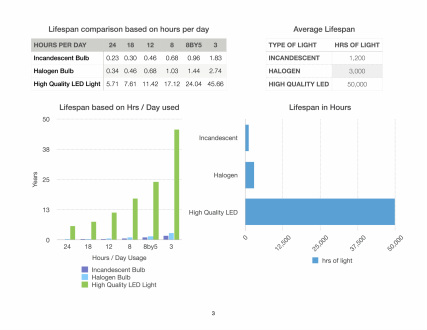
- 24 hrs/day 7 days/week 5.7 years
- 18 hours per day 7.6 years
- 12 hours per day 11.4 years
- 8 hours per day 17.1 years
- 8 hrs/day 5 days/week 24 years
- 3 hrs/day (7 days/ wk) 45.66 years
- 24 hours a day 83 days (less than 3 months)
- 18 hours per day 111 days (less than 4 months)
- 12 hours per day 167 days (less than 6 months)
- 8 hours per day 250 days (less than 9 months)
- 8 hours / day 5 days / week (about 1 year)
- 3 hours per day 667 days (less than 1.85 years)
So, again, what does this mean?
- The incandescent light will need to be purchased (at additional cost) 25 times during the LED life
- The labor to replace the light will have to be purchased / spent 25 times during the LED life
- The equipment to install the light (lift, etc.) will have to be rented 25 times during the LED life
- The relationship between the Total Lighting Cost (TLC) and the cost of the light itself changes
- The initial cost of the fixture
- The energy to power it (operating costs), and
- Any maintenance required to keep it working (including replacement fixtures, labor and disposal).
Here is an example to illustrate the change in relationship because of longer lasting LEDs. If an industrial light costs $100 to purchase up front, and costs $50 per year for the energy to produce the light and the light lasts two years, the light (bulb) itself is about 50% of the total lighting cost of providing the lighting over the life of the fixture ($100 bulb + $100 energy [that is 2 x $50 per year] = $200, so 100/200 = 50% of the TLC is for the bulb).
However, if that same hypothetical light was to last 10 years, the equation stays the same, but the cost of the light becomes only a small portion of the TLC. If the light costs $100 to purchase and $50/year to run, but lasts 10 years (conservative for an LED that is on 12 hours per day 7 days per week), the light (bulb) itself only represents about 17% of the cost to provide the light.
($100 bulb + $500 energy cost [50x10] = $600 TLC, so bulb is 100 / 600 or about 17% of the TLC.)
Everyone knows that traditional incandescent light bulbs need TLC (tender loving care) when handling them so they don't break. Now, even though they are much more durable (learn more about that here), LED's should still make you think of TLC - the Total Lighting Cost - because the long life of high quality LEDs makes the up front cost a much smaller factor in TLC due to their 50,000 hour lifespan.
 RSS Feed
RSS Feed
